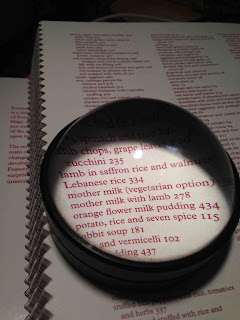You know, I hear they was really tiny guys.
~ Napoleon Bonapart (Ian Holm)
Time Bandits
 |
| Lebanese rice; once you find it, it's not there |
Lilliputian font wouldn't be an issue on a tablet like the iPad or its competitors. Reading on a tablet can be a great experience for so many reasons. A mundane point I particularly like is the ability to change font size as desired; quite literally, font size there is as arbitrary as it is irrelevant. Too small? Make it big. Too big? Make it small. Don't like that font? Change it to another style entirely. But books — printed books — are ancient technology; one cannot double-tap the page to bring up a definition or shrink the image by squeezing together thumb and forefinger. Once it's printed, it's printed and there's no changing it. One does not simply make the font bigger or re-flow the copy on a printed page; it's locked.
 |
| Kona Stout Ice Cream ingredients |
A plea, then, for book designers and publishers; if something is worth putting in the book, it's worth doing it right. Not everyone has fancy glass magnifying domes or the gimlet eyes of a 23-year old designer. Don't give the mechanics such short shrift; make indicies, instructions, and ingredients lists as legible as head notes, introductions, and forewords.
Goes well with:
- Know who has a great index? C. Anne Wilson in her distilling history, Water of Life.
- The dome magnifier above came with my copy of The Compact Oxford English Dictionary. Decent models can be found online for under $50. Here's a sampling.
- Speaking of short shrift and completely off-topic: one of the best lines about ugly kids remains "I was so ugly as a child that my parents put me in dark corner and fed me with a slingshot."
No comments:
Post a Comment